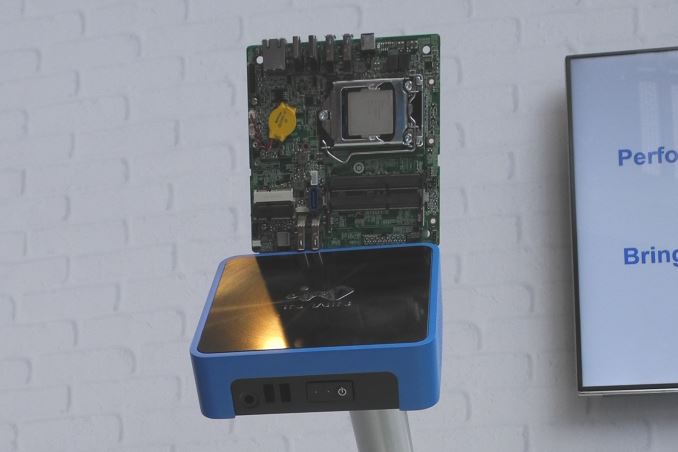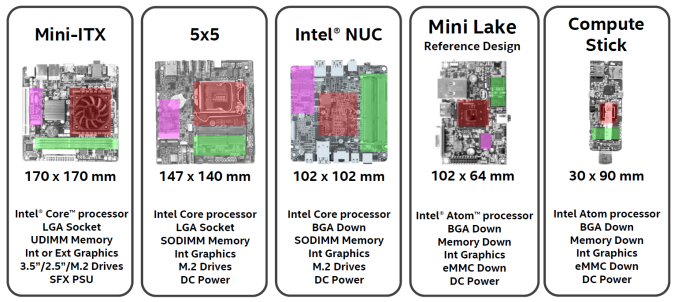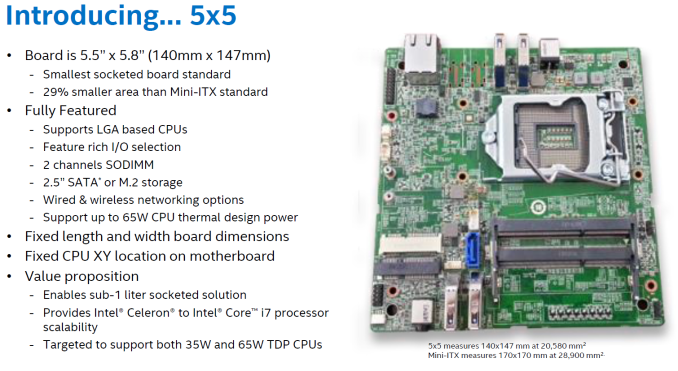Intel Launches New Socketed 5x5 mini-PC Motherboards
by Ganesh T S on August 24, 2015 4:35 AM EST- Posted in
- Trade Shows
- Systems
- Intel
- Motherboards
- Mini-PC
- IDF 2015
- 5x5

Over the last couple of years, the ultra-compact form factor (UCFF) has emerged as one of the bright spots in the troubled PC market. Kickstarted by Intel's NUC (Next Unit of Computing) designs, it has been successfully cloned by other vendors such as GIGABYTE (BRIX), Zotac (C-series nano) and ASRock (Beebox). With platform performance increasing every generation, and performance requirements getting tempered by the rise of the not-so-powerful smartphones and tablets, Intel could pack a heavy punch with their 102x102mm NUC motherboards.
Atom-based units (using Bay Trail) could provide very good performance for most users. Intel tried to shrink the PC even further by releasing a Compute Stick based on the Bay Trail Atom Z series SoCs earlier this year. ECS, with their LIVA designs, has adopted the Mini Lake reference design for their UCFF PCs. All of these UCFF PCs come with BGA CPUs / SoCs. The configurability aspect is minimal from an end-user's perspective. Looking at the mini-ITX form factor immediately leads us to a hole in the mini-PC lineup between it and the NUC.
At IDF last week, Intel quietly launched the new 5x5 motherboard form factor. Coming in at 147x140mm, it is closer to the NUC in the fact that it can operate directly off DC power and takes SODIMM memory. Approaching from the mini-ITX side gives us the LGA socket for a Core processor. Unfortunately, at this size, we have to make do without the full length PCIe slot.
Intel suggests that solutions using the 5x5 boards could come in with a 39mm height for a volume of 0.89L (when using M.2 drives and a heat sink suitable for 35W TDP CPUs). 65W TDP CPUs and 2.5" drive support would obviously increase the height requirements.
Many usage areas which required custom-sized embedded boards (such as digital signage / point of sale terminals / kiosks etc.) have now opened up for the PC, thanks to the NUC and other similar form factors that were introduced over the last year or so. The new 5x5 form factor ensures that a mini-PC is available for every size and performance requirement. As of now, it looks like In-Win has a chassis design ready for the new form factor. We are awaiting more information on the board(s) and availability details.












44 Comments
View All Comments
colinstu - Monday, August 24, 2015 - link
DC power only?! AWESOME. What I hate about these small mobos but only take 24pin power... ridiculous. Excited to see new motherboards come in this form factor.DanNeely - Monday, August 24, 2015 - link
That actually does raise a question. Intel's reference board has a sata port; but I don't see a plug on the board to get power off for the drive...nightbringer57 - Monday, August 24, 2015 - link
It's probably one on the small white headers around the SATA port?DanNeely - Monday, August 24, 2015 - link
I don't think so. Zooming in, the one above looks like a USB2/Audio header. The one to the left is a fan header, and the things below I think are a pair of on board front panel USB ports similar to the ones on the top edge.taisingera - Monday, August 24, 2015 - link
There could be a special cable, USB2 header to SATA power to power a 2.5" hard drive/SSD. Those only need 5V/1A to run.Guspaz - Monday, August 24, 2015 - link
What's the point of this, exactly? It's got all the limitations of NUC, but much bigger. The only thing you seem to gain is a CPU socket, but few people are likely to upgrade the CPU in this small of a machine (particularly one without any PCIe slots).nightbringer57 - Monday, August 24, 2015 - link
As far as I know, the NUC platforms target CPUs with a TDP of at most 30-35W. This allows 65W TDP CPUs. This can lead to a huge leap in performance.Guspaz - Monday, August 24, 2015 - link
That's true, although they also say this thing is for 35W CPUs (in addition to 65W CPUs)That only raises the question, what use case is it good for? Intel's 6th gen desktop CPUs have a 91W TDP, so 65W isn't getting you a current-gen desktop chip (the 5th gen desktop CPUs are 65W, though), so clearly this isn't intended to be used in a system that needs the most performance. Yes, you're going to get more performance out of a 65W chip than a 35W chip, but what use case requires more performance than you get out of a 35W chip, but still doesn't require a discrete graphics card?
All the use cases that I can think of for systems with no discrete graphics would work perfectly fine with a 35W CPU. You can get pretty good performance out of 35W: the i7-4785T, for example, which is a 35W part, is a quad core (with hyperthreading) and a clock range of 2.2 GHz to 3.2GHz... and it'd be overkill for any sort of office use.
V900 - Monday, August 24, 2015 - link
You're not even close there...Sure the Skylake parts that Intel just launched has a TDP of 90W. But they'll launch the 30-60W Skylake I7 parts in Q4 this year and Q1-2 next year.
Until then you could put the
nightbringer57 - Monday, August 24, 2015 - link
The platform power is always a range ;)Like NUC aims for 7-28W processors (as far as I can tell), this aims for 35-65W processors.
You can have a 28W processor in a NUC form factor that has performances similar to a 35W model, but I bet there will be some issues due to the CPU TDP being much closer to the maximum limit of the cooler (whereas a 35W CPU on a "up to 65W" cooler would be much better off)
Even if last-gen 65W CPUs don't exist yet, I don't think this hole will be left vacant for so long.
And office and gaming aren't the only things in life.
There are many niches where you need processing power but don't care about having more than decent-to-high amounts of RAM and storage, while the storage speed will be fine with a SSD anyway. Obviously, those are not typical consumer uses but I think the sheer number of said niches would make up for a decent market size. At least Intel seems to think that way.
And I think 35-65W low-end socketed CPUs have a much better price/performance ratio than similar 17-28W parts. So this platform would allow for lower prices with decent performances in the low end, and more raw performance in the high-end if required.